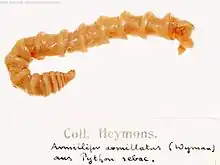Armillifer armillatus
Armillifer armillatus is a species of the genus Armillifer[1] occurring in tropical Africa.[2] Its typical definitive hosts are pythons, such as the African rock python, while rodents are presumed to act as intermediate hosts. Humans may become accidentally infected by the eggs particularly if consuming (or otherwise contacting) infected snakes. Ingested eggs develop into nymphs that invade different visceral organs causing a disease called porocephalosis. Most human infections are asymptomatic, some are debilitating, or rarely even lethal.[3][4]
| Armillifer armillatus | |
|---|---|
 | |
| A 4 cm specimen from the respiratory tract of Python sebae | |
| Scientific classification | |
| Kingdom: | |
| Phylum: | |
| Subphylum: | |
| Class: | |
| Subclass: | |
| Family: | Porocephalidae |
| Genus: | |
| Species: | A. armillatus |
| Binomial name | |
| Armillifer armillatus (Wyman, 1848) | |
Most of the pythons sold for human consumption at the rural bushmeat markets in the DR Congo host Armillifer armillatus.[5]
References
- Chen SH, Liu Q, Zhang YN, et al. (2010). "Multi-host model-based identification of Armillifer agkistrodontis (Pentastomida), a new zoonotic parasite from China". PLoS Neglected Tropical Diseases. 4 (4): e647. doi:10.1371/journal.pntd.0000647. PMC 2850311. PMID 20386597.
- Christoffersen ML, De Assis JE (2013). "A systematic monograph of the Recent Pentastomida, with a compilation of their host". Zoologische Mededelingen. 87: 1–206. Archived from the original on 2014-11-08. Retrieved 2018-01-17.
- Mapp EM, Pollack HM, Goldman LH (May 1976). "Roentgen diagnosis of Armillifer armillatus infestation (porocephalosis) in man". Journal of the National Medical Association. 68 (3): 198–200, 191. PMC 2609651. PMID 933188.
- Tappe D, Büttner DW (2009). "Diagnosis of Human Visceral Pentastomiasis". PLoS Neglected Tropical Diseases. 3: 1–7. doi:10.1371/journal.pntd.0000320. PMC 2643528. PMID 19238218.
- Hardi R, Babocsay G, Tappe D, Sulyok M, Bodó I, Rózsa L (2017). "Armillifer-infected snakes sold at Congolese bushmeat markets represent an emerging zoonotic threat" (PDF). EcoHealth. 14: 743–749. doi:10.1007/s10393-017-1274-5. PMC 7088293. PMID 29030787.
This article is issued from Wikipedia. The text is licensed under Creative Commons - Attribution - Sharealike. Additional terms may apply for the media files.